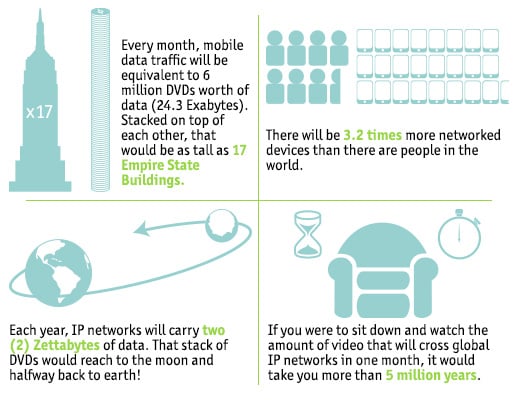An Evolution in Wireless
In Cisco’s 2016 Visual Networking Index (VNI), it is stated that; “In North America, mobile data traffic by 2020 will be equivalent to 52x the volume of North American mobile traffic ten years earlier (2010).” Another prediction stated in Cisco’s 2016 VNI report is: “In North America, mobile data traffic will grow 2 times faster than fixed IP traffic from 2015 to 2020.” There truly is an evolution in wireless happening right before our eyes. In order to prepare for this tremendous growth on your network, you need to understand what to prepare for. Berk-Tek can help you by providing the information you need to make an informed decision.

The wireless evolution is the result of not only the billions of new wireless devices that are connecting each year, but also the growing bandwidth that each device is capable of generating, transmitting and receiving (think 4k UHD video, high resolution photos, etc.). This is why we have the new IEEE 802.3ac standard. When fully rolled out in 2018 (est.), this technology will allow up to 6.9Gbps of bandwidth to flow from the wireless access points (WAPs) back to the IDF. With so much IP traffic flowing from the WAP to the IDF, it doesn’t make sense to use multiple 1Gbps cables to connect.
Another standard in development now is the IEEE 802.3ax (1st generation devices expected to start hitting the market by 2019). This standard will also be a multi-phase rollout like 802.11ac, and when the technology is full implemented, it is likely to allow for a four-fold increase in bandwidth over 802.11ac! This means that when 802.11ax technology is fully deployed, close to 30Gbps could be transmitted from the WAPs back to the IDF or Telecom Room.
One other important point to keep in mind is as bandwidth increases, reach decreases. The same physics apply regardless if the medium used is copper, fiber, or wireless. Therefore, since it will take more WAPs to cover the same square footage when bandwidth grows, then it makes sense to pull multiple Category 6A (10Gbps) cables to each WAP now. In so doing, you are prepared for both bandwidth growth and when it becomes necessary to add more WAPs to provide the same great WiFi service to your customers and employees.
Next Gen Wireless: What You Need to Know to Stay Ahead of the Wave
- The drivers and projected growth of wireless traffic
- Impact of wireless growth to current deployments
- Next generation wireless technologies



.png?width=58&height=58&name=X_logo_2023_(white).png)
